Hammer Museum
The Hammer Museum at UCLA believes in the promise of art and ideas to illuminate our lives and build a more just world. The Hammer Museum champions the art and artists who challenge us to see the world in a new light, to experience the unexpected, to ignite our imaginations, and inspire change. The Hammer understands that art not only has the power to transport us through aesthetic experience but can also provide significant insight into some of the most pressing cultural, political, and social questions of our time. We share the unique and invaluable perspectives that artists have on the world around us. A vibrant intellectual and creative nexus, the Hammer is fueled by dynamic exhibitions and programs—including lectures, symposia, film series, readings, and musical performances—that spark meaningful encounters with art and ideas. And through our unwavering commitment to free admission and free public programs, the Hammer is open for all and FREE FOR GOOD.
History
The Hammer Museum opened to the public in November 1990. Founded by Dr. Armand Hammer, former Chairman of Occidental Petroleum Corporation, the Museum was designed by architect Edward Larrabee Barnes. Financed by Occidental, the Museum was built adjacent to the Corporation’s international headquarters in Westwood. At that time, the Museum featured galleries for Dr. Hammer’s collections — old master paintings and drawings, and a collection of works on paper by Honore Daumier and his contemporaries — as well as galleries for traveling exhibitions. Dr. Hammer passed away in December 1990, three weeks after the opening of the Museum leaving many spaces unfinished.
In 1992, the Museum began negotiations with its neighbor, University of California, Los Angeles (UCLA), to assume the management and operations of the institution. In April 1994, the partnership with UCLA was finalized and the following year the University relocated its collections and the staff of the Wight Art Gallery and the Grunwald Center for the Graphic Arts to the Hammer. The Museum also assumed responsibility for the Franklin D. Murphy Sculpture Garden, located at the north end of the UCLA campus.
Henry Hopkins, then director of the Wight gallery and professor in the Department of Art, became director of the Museum until his retirement in 1998. In 1999 Ann Philbin was named director and has developed a strong and original institutional identity and built a national and international reputation for thematic contemporary exhibitions, scholarly historical exhibitions, and contemporary artists’ projects. During her tenure the Hammer has formed a Hammer Contemporary Collection which now holds over 2,000 artworks. In addition, Philbin has overseen substantial renovations to the museum’s building, including the completion of the 300-seat Billy Wilder Theater and museum café. With Philbin’s direction, the museum instituted the internationally acclaimed Hammer Projects, a series of more than one hundred contemporary exhibitions and installations featuring local, national, and international emerging artists.
Philbin also created a series of dynamic public programs which are core to the Hammer’s identity and regularly feature many of the most influential authors, artists, and creative thinkers of our time
10899 Wilshire Blvd, Los Angeles, CA 90024
hammer.ucla.edu
+1 310-443-7000



